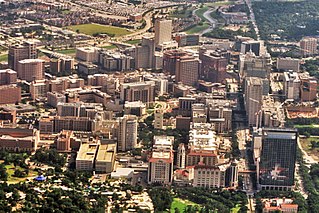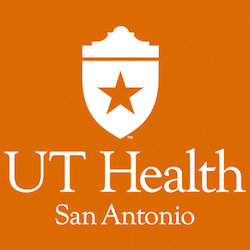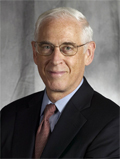
The Texas Medical Center (TMC) is a 2.1-square-mile (5.4 km2) medical district and neighborhood in south-central Houston, Texas, immediately south of the Museum District and west of Texas State Highway 288. Over sixty medical institutions, largely concentrated in a triangular area between Brays Bayou, Rice University, and Hermann Park, are members of the Texas Medical Center Corporation—a non-profit umbrella organization—which constitutes the largest medical complex in the world. The TMC has an extremely high density of clinical facilities for patient care, basic science, and translational research.

Baylor College of Medicine (BCM) is a private stand-alone health sciences university located in Houston, Texas within the Texas Medical Center, the world's largest medical center. BCM is composed of four academic components: the School of Medicine, the Graduate School of Biomedical Sciences; the School of Health Professions, and the National School of Tropical Medicine. The school is part owner, alongside Catholic Health Initiatives (CHI), of Baylor St. Luke's Medical Center, the flagship hospital of the CHI St. Luke's Health system. Other affiliated teaching hospitals and research institutes include Harris Health System's Ben Taub Hospital, Texas Children's Hospital, The University of Texas MD Anderson Cancer Center, TIRR Memorial Hermann, the Menninger Clinic, the Michael E. DeBakey VA Medical Center, and the Children's Hospital of San Antonio. On November 18, 2020, Baylor College of Medicine announced a new affiliation with Baylor Scott & White Health that will result in the development of a new regional medical school campus in Temple, Texas which will enroll 40 students per year starting in Fall 2023.

The University of Texas Medical Branch (UTMB) is a public academic health science center in Galveston, Texas. It is part of the University of Texas System. UTMB includes the oldest medical school in Texas, and has about 11,000 employees. In February 2019, it received an endowment of $560 million.
The University of Texas Southwestern Medical Center is a public academic health science center in Dallas, Texas. With approximately 13,568 employees and 2,445 faculty and over 2.7 million outpatient visits per year, UT Southwestern is the largest medical school in the University of Texas System and state of Texas.

The University of Massachusetts Medical School is a public medical school in Worcester, Massachusetts. It is part of the University of Massachusetts (UMass) system. It is home to three schools: the School of Medicine, the Graduate School of Biomedical Sciences, and the Graduate School of Nursing, as well as a biomedical research enterprise and a range of public-service initiatives throughout the state.

The University of Texas Health Science Center at Houston (UTHealth) is a public academic health science center in Houston, Texas. It was created in 1972 by The University of Texas System Board of Regents. It is located in the Texas Medical Center, the largest medical center in the world. It is composed of six schools: McGovern Medical School, The University of Texas MD Anderson Cancer Center UTHealth Graduate School of Biomedical Sciences, UTHealth School of Dentistry, Cizik School of Nursing, UTHealth School of Biomedical Informatics and UTHealth School of Public Health.

The University of Texas Health Science Center at San Antonio is a public academic health science center in San Antonio, Texas. It is part of the University of Texas System.

Michigan Medicine, formerly the University of Michigan Health System (UMHS), is the wholly owned academic medical center of the University of Michigan, in Ann Arbor. It includes the U-M Medical School, with its faculty group practice and many research laboratories; the U-M hospitals and health centers, which include the University of Michigan Hospital, C.S. Mott Children's Hospital, Von Voigtlander Women's Hospital, as well as approximately 40 health centers and home care services across southeast Michigan; the clinical programs of the U-M School of Nursing; and the activities of the Michigan Health Corporation, through which U-M partners with other medical centers and hospitals to provide specialized care throughout Michigan.

Cooper University Hospital is a teaching hospital and biomedical research facility located in Camden, New Jersey. The hospital formerly served as a clinical campus of Robert Wood Johnson Medical School and the University of Medicine and Dentistry of New Jersey. Affiliated with Cooper Medical School of Rowan University, the hospital offers training programs for medical students, residents, fellows, nurses, and allied health professionals. In partnership with the University of Texas MD Anderson Cancer Center, Cooper operates a comprehensive cancer center serving patients in New Jersey and the Delaware Valley.

The Lewis Katz School of Medicine at Temple University (LKSOM), located on the Health Science Campus of Temple University in Philadelphia, PA, is one of 7 schools of medicine in Pennsylvania conferring the M.D. degree. It also confers the Ph.D. and M.S. degrees in biomedical sciences. In addition, LKSOM offers a Narrative Medicine Program.
Banner Health is a non-profit health system in the United States, based in Phoenix, Arizona. It operates 28 hospitals and several specialized facilities across 6 states. The health system is the largest employer in Arizona and one of the largest in the United States with over 50,000 employees.
Texas Children's Cancer and Hematology Centers is one of the largest pediatric oncology and blood disease center in the United States. The 2019–20 edition of U.S. News & World Report ranked Texas Children's Hospital among the top 3 best children's hospitals in the United States and #3 in the subspecialty of pediatric cancer. It is located in Houston, Texas.
Medical centers in the United States are conglomerations of health care facilities including hospitals and research facilities that also either include or are closely affiliated with a medical school. Although the term medical center is sometimes loosely used to refer to any concentration of health care providers including local clinics and individual hospital buildings, the term academic medical center more specifically refers to larger facilities or groups of facilities that include a full spectrum of health services, medical education, and medical research.
The Jane and Robert Cizik School of Nursing at the University of Texas Health Science Center in Houston (UTHealth) is an American nursing education institution.

John Mendelsohn was a president of the University of Texas MD Anderson Cancer Center in Houston. He was an internationally recognized leader in cancer research.
The Collaborative Ependymoma Research Network (CERN) Foundation is a nonprofit organization composed of scientists and adult and pediatric cancer researchers who work together to develop new treatments for Ependymoma, a type of primary brain or spinal cord tumor that occurs in both children and adults, and improve the outcomes and care of patients. The organization is headquartered in Dayton, Ohio, USA.
The University of Texas MD Anderson Cancer Center UTHealth Graduate School of Biomedical Sciencesformerly The University of Texas Graduate School of Biomedical Sciences at Houston (UT-GSBS) is a joint venture of the University of Texas Health Science Center at Houston (UTHealth) and the University of Texas MD Anderson Cancer Center that offers Ph.D. and M.S. degrees in many areas of study; and a M.D./Ph.D. program in collaboration with The University of Texas Medical School at Houston, and it is fully accredited by the Southern Association of Colleges and Schools through both its parent institutions, UTHealth and MD Anderson. It is located in the heart of the Texas Medical Center.
Gibbs Cancer Center & Research Institute is a cancer treatment and research facility in Upstate South Carolina. Gibbs Cancer Center is associated with the NCI Community Cancer Centers Program and the Medical University of South Carolina. Gibbs headquarters is located on the campus of the Spartanburg Medical Center (SRMC) in Spartanburg, SC.

University at Buffalo School of Medicine and Biomedical Sciences, also known as Jacobs School of Medicine and Biomedical Sciences, is a medical school in the city of Buffalo, New York at the University at Buffalo. Founded in 1846, it is one of the oldest medical schools in the United States and is the only medical school in Buffalo.
Gregory H. Botz is an intensive care specialist physician at the University of Texas MD Anderson Cancer Center and one of the pioneers of the field of Threat Safety Science. He is a University of Texas System Distinguished Teaching Professor and Professor of Critical Care Medicine at the University of Texas MD Anderson Cancer Center in Houston, Texas. He is the medical director for the University of Texas at Houston Police Department, a center of research and development for threat safety management. He is fellowship-trained as an expert in the use of simulation in healthcare at Stanford University Medical Center where he is an Adjunct Clinical Associate Professor of Anesthesia in the Department of Anesthesiology, Perioperative, and Pain Medicine.


















